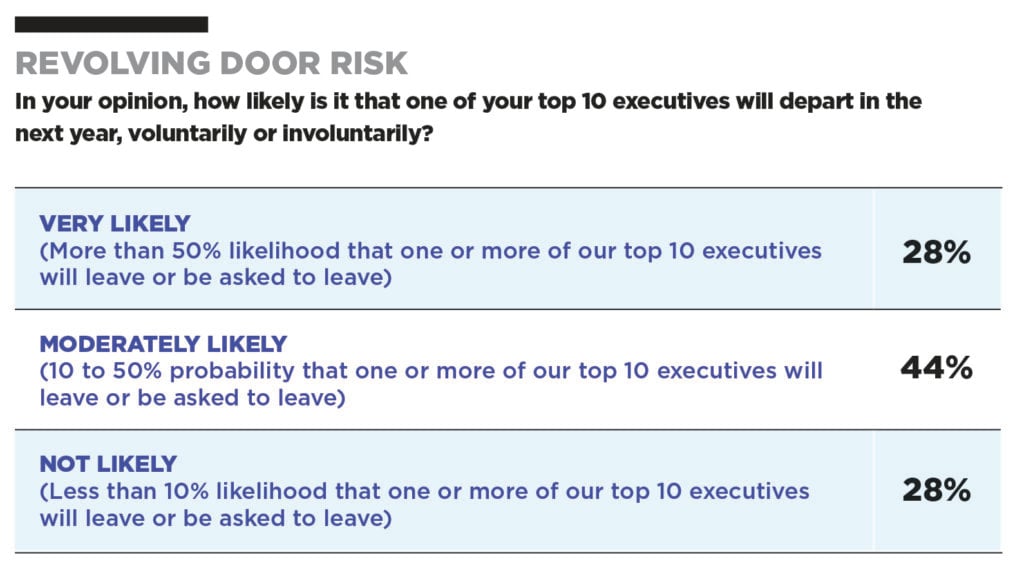Over the past several years, the scrutiny of corporate governance has continued to intensify. Corporate directors are under increasing pressure to provide effective oversight and strategic contribution to the companies they govern.
We at RHR have noticed in the last several years that this pressure, both in Europe and the United States, is shifting away from a board’s focus on statutory and regulatory compliance to more fundamental matters of board competency, culture, and strategic focus—process and group dynamics matters.
Coincidental with this shift, many of RHR’s board-level clients have asked for support in fulfilling their responsibilities for upgrading director competency and continually improving board governance. We are experiencing increasing demand for professional service in three key areas of board impact: first, the board’s annual self-evaluation; second, the process of CEO succession planning; and third, CEO performance management and development.
Given these trends, the leadership team at RHR decided to undertake a research program to develop and disseminate insights to the governance community about the components of a great board. We used the following gateway questions:
• What are the building blocks of a great board?
• What differential value does a great board contribute to the company it directs compared to a typical board?
• How does a great board function differently than a typical board?
The Definition of a Great Board
A great board is a team of exceptionally competent leaders committed to the long-term mission of the business. These leaders understand their singular accountability is pursuing their shareholders’ best interests while considering the interests of other stakeholders. Within great boards, there is clear understanding and alignment of purpose, priority and resource allocation. An uncompromising attention to ethical values prevails at the board level, along with unwavering insistence that these values cascade throughout the operating organization.
Directors are astute reads of marketplace signals; they are rarely surprised. Their edge over typical boards is their ability to anticipate the future—to seize emerging opportunities or craft prudent defensive actions to protect the enterprise. Great boards are collections of talented leaders with diverse perspective that add value. Directors are superb talent scouts and able talent developers. Great boards find ways to play well together in deliberation and quality of decision making. Ultimately, great boards win in the marketplace.
To bring the definition more to life, several quotes from our interviews provide interesting context and insightful color to the description of a great board:
• Attention to shareholder interests. Shareholders’ interests are always front and center; the egos, personal agendas, and biases are put away.
• Belief in the mission. Directors must believe in the mission and thoroughly understand the business model.
• Chemistry among directors. Directors are mutually supportive collaborators, beyond being just friends. These are teams that have meaningful interactions both inside and outside the boardroom.
• Constructive relationships with management. Great boards have a sound read of the capability and biases of the CEO and senior management. Great boards provide leadership and guidance of the “what”; they don’t micromanage the “how.” Great boards know the bright line separating governance and operating matters … and when and how to cross that line when necessary.
• Engagement. These are teams that put in emotional energy—not just time.
• In-depth business expertise. Great boards are populated with directors who have the capability and instinct to think ahead of the business. Great leaders are skilled in aligning values, tapping diverse perspectives and experience, and expecting a lot. And they’re hellbent to win in the marketplace.
• Asking the right questions. Great boards are curious. Great directors ask great questions— questions that are targeted; questions that go deeper, into different space; and, importantly, questions that teach a different type of thinking.
• Great boards? It boils down to competence, confidence, character and chemistry.
The Building Blocks of a Great Board
Our research brought focus to the building blocks for a great board. The net effect when these building blocks are in place is a board that adds great value in guiding and supporting the management of the enterprise to effectively choose and execute strategies that enable the enterprise to fulfill its mission and compete successfully against competitors in the marketplace, in both the short term and a long-term sustainable capability.
It is important to note that these building blocks are measurable and replicable; they also require regular attention and reinforcement. Our survey puts a spotlight on the importance of team learning for the creation and maintenance of a great board.
Clear and Aligned Purpose
Many of the directors we interviewed talked about how critical it is for everyone on a board to have a shared agenda and for that agenda to supersede the agendas of individual board members. Some directors went further and emphasized the importance of financial alignment such that directors’ interests and efforts are in line with shareholders’ interests. Complexity and the resulting challenges come when directors represent different constituents and agendas with interests, timelines, and values that diverge.
Diverse, Engaged and Experienced Directors
Once there is a clear and explicit charter for the board, the second core foundational element for a great board is the board composition. The board members we interviewed outlined several criteria for selecting the right group of directors to compose a great board. They told us that directors of great boards need to:
• Have industry and/or functional experience and expertise that directly maps to the business and strategy of the enterprise they direct
• Possess a strong service orientation and can subordinate their egos to the service mission
• Bring diverse backgrounds and perspectives that enrich boardroom dialogue, analysis, insights, and problem solving
• Demonstrate emotional intelligence in their interactions with other board members and management
• Collaborate well with others
Board Leadership
Great boards don’t materialize without great board leadership. Leadership is the essential catalyst for the other building blocks of great boards. Our research uncovered eight essential roles a board leader must play on a great board. These “Great 8” roles are described below, along with anecdotal comments from our director interviews about these roles and their impact on board competency and contribution to the business.
1. The Orchestra Conductor. The chair is the lead facilitator. A great chair tees up the right issues, and these are resolved with thorough deliberation and decision making. They don’t have to necessarily have all the answers, but they certainly ask the questions and draw out the best thinking. They bring the best ideas out of every director and work with directors to mold the solution to each of the problems that arise. They invite open discussion and debate but walk the line to make sure there’s action. They set the right agenda and drive constructive deliberation through to timely decisions. They focus on the right topics, making sure dialogue stays at the right level. They bring focus to the right issues at the right time with the right degree of intensity. They know where to poke and when to stop.
2. The Galvanizer. Board leadership attracts great talent and enlists them in a common pursuit of special goals and achievements. They make sure people are engaged and inspired. They make sure they’re aligned on key priorities and know where they want to go. They broker consensus amidst dissension. Chairs work the room well: they are contagiously confident.
3. The Culture Steward. Great leadership creates an environment where all directors are fully engaged and involved—they get every director “under the tent.” Positive conflict is encouraged. Everyone has a voice. They’re intentional about setting the tone, creating the culture that supports strategy and what they must accomplish. They create a culture that promotes open discussion, the ability for everyone to be heard, service, and role clarity. They have genuine respect for people with different opinions.
4. The Visionary. Great leadership always has their eyes and aspirations on the future—a future they set or a future they must react to. They set the framework within which other directors are going to develop strategy and direction for the business. They supervise the vision and strategy for the company. This person is a critical thinker who is consistent in his/her approach to decision making and values.
5. The Operator. Great leaders ensure the day-to-day matters are handled—no surprises. Governance. Reporting. Compliance. They interact with the market and shareholders. They put in behind-the-scenes work to make sure directors are prepared for meetings. They set the agenda for board meetings. They have proper information flow and make sure people are properly educated on issues. They make sure all issues get on the table, and have a governance process that enables and supports the management team, but also holds them very much accountable. This person is careful and skilled in not owning problems but overseeing solutions. They are masters of the tactical pieces of the role.
6. The Talent Manager. Knows the skills, experiences, and perspectives needed from other board members as well as from the senior team. They recruit and ensure proper skillsets are on board, making sure the right people are in the right place (e.g., committee membership). They encourage growth on the part of the board members and get them to stretch their minds. They manage turnover and act as a great coach. They are engaged in evaluation and feedback (both individually and collectively).
7. The Advisor. Great board leaders are effective coaches— they listen, shape, and guide the CEO in very personal ways. These are personal relationships that must work for a board to be great. This person is a close partner and sounding board for the CEO and their team. They have the CEO’s trust and respect, as well as regular interaction. They support the CEO and act as a buffer between the board and the CEO. This person helps the CEO understand what is going on with the board and vice versa. They provide feedback but do not interfere or micromanage. They provide invaluable advice and counsel to the CEO.
8. The Ambassador. Great board leaders have strong connections in the external world—customers, competitors, suppliers, regulators, politicians, and other key stakeholders. They can access influence from the external world. They are highly communicative, and ensure the right communication flow amongst members. They act as direct line of communication outside of board meetings and with each of the board members.
Culture
Culture represents the prevailing norms, practices and often the unwritten rules for how any organization does business: “It’s the way we do things around here.” Boards have cultures that may be dysfunctional because they exert too strong an influence over the operating organization, are too weak, or are stale and out of date. These cultures impede fresh thinking and constructive debate; they cause “drag” on the business. Great boards are characterized by norms and practices that are genuinely curious about the business and foster engagement, innovation, and performance excellence—great board cultures provide “lift” to the business.
In our research, culture was viewed as a key determinant of a great board. Its importance was repeated throughout our interviews and responses from the 291 respondents to the Great Boards questionnaire as a crucial differentiator between great boards and typical ones. The top two factors that directors most often cited as contributors to the making of a great board were the quality of boardroom dialogue and debate (88%) and the ability to ask the tough questions of management (77%). The two top factors they cited as undermining board effectiveness were lack of candor in the boardroom (77%) and lack of mutual respect and a collaborative culture (68%). Many directors commented on the importance of healthy conflict and tension in the boardroom to fully explore issues from different perspectives and challenge the status quo.
Among other things, a board of directors is a group of people subject to the same dynamics that social psychologists have found operative in any small group—forces of social conformity, group-think, the potential for diffusion of responsibility, etc. Board members are often prominent members of an industry sector of the business community, and directors have conscious and often unconscious motivations to maintain collegial relationships with each other and the board chair so as not to rock the boat.
A great board chair or lead director must skillfully manage these group dynamics in a way that propels the whole board to be greater than the sum of its parts and to minimize the adverse consequences of undermining small group dynamics.
Size does seem to matter. A notable theme related to board culture related to board size. Many directors recommended a smaller board size (fewer than 10 directors) to enable more candid and less formalized interactions in the boardroom.
Best Practices
With the first four foundational blocks in place—shared purpose, the right composition, great leadership, and a culture that is simultaneously collegial and challenging—a board can embrace best practices in core areas of responsibility: strategic oversight, its fiduciary and risk management, CEO performance and succession, as well as its own ongoing continual improvement and renewal. Great boards have sound processes to manage each of these areas. In our interviews with directors, themes for how great boards do so were as follows:
• Strategic oversight. A great board possesses great business and industry acumen such that it is not only well versed in the current state of the enterprise and competitive landscape, but devotes attention and resources to mid-term and balances attention to short-term, midrange and longer-term direction and strategy.
• Fiduciary duty and risk management. Unlike boards of many financial services companies in the first decade of the 2000s, great boards have a thorough appreciation of revenue sources and threats, and insist on disciplined processes to manage financial, environmental, political, regulatory, reputational and cyber threats to the business.
• CEO performance and succession. The selection and deselection of the CEO is perhaps a board’s most important responsibility, and great boards invest continual attention and diligence to this process. While average boards often don’t actively manage the CEO, great boards and great board chairs/lead directors establish an open and close partnership with the CEO in setting explicit expectations and supporting the execution of them. Great boards commit to a disciplined rhythm of talent development for all mission-critical roles, with particular attention to the candidate pipeline for the CEO position.
• Board renewal. The competitive landscape in business these days compels a continual improvement ethic for any enterprise to be successful. That holds true for boards as well, and the best boards devote time and attention to regular reviews of how they are functioning. Substantive full board evaluations, as well as actionable feedback to each director on at least an annual basis, is a best, if relatively uncommon, practice. Only 36% of directors in the NYSE survey reported that their most recent board evaluation process was very effective. In the interviews we conducted with directors, most indicated that director feedback and removal was a most difficult and awkward task, but said that the best board chairs courageously took on that task when needed. Mandatory retirement ages were the most commonly cited way most boards use for director replacement. Comments were also offered that the tradition of board members serving terms in excess of 10 years should be replaced with shorter tenures wherein directors move in and out of the boardroom more frequently to ensure relevant director-level expertise is always abundant.





